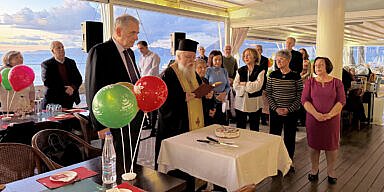We Greeks knew the Earth was a globe since ancient times. The round shape and phases of the moon and the earth’s shadow on it during even partial eclipses gave the philosophers a clear idea – only a globe could cast such a shadow on another world. And, of course, Greeks being mariners, had long known its curvature from watching ships “go over” the horizon. The mariners had ventured beyond the “Pillars of Hercules” (Gibraltar) and had reached islands in the Atlantic Ocean, such as the Azores and the Canaries. People had also been trading across the Mediterranean and then overland for centuries with the mysterious “Far East” exotic places such as China and “Chipango” (Japan.)
Many people had stared out to sea from the Western shores of Spain and Portugal, wondering if it would be possible to sail West and reach the “Far East” by sea. But no one knew how far they had to travel. One of those persons, the experienced mariner Christopher Columbus, decided to study the issue, delving into the available information of the time.
He knew that Eratosthenes, the managing director of the famous Library of Alexandria, had determined, around 200 B.C., the Earth’s circumference (within an incredibly accurate 1% – 2% of the figure we use today.) The Greeks had used “stadia” as measurements of distance, which had been taken up by the Romans, who in turn translated them into “miles,” and based on this “Roman mile,” the circumference of the Earth was 26,400 miles.
But he also read that Eratosthenes was not the only one that sought to find the Earth’s circumference. In the early years of the Muslim faith, around 830 A.D., the Chalif Al-Ma’mun ordered his capable astronomer/mathematicians to determine the circumference. Both philosophers had estimated the Earth’s correct size reasonably close, and their numbers varied only because their “measuring stick” was different. So they came up with the same circumference, more or less, their methods limiting their accuracy somewhat, but they used their own “miles,” which were of a different size; and based on their “Arab miles,” the circumference of the Earth was 20,700 miles.
Being an optimist (as any adventurer should be), Columbus assumed the lesser circumference of 20,700 miles. His next step was to determine the Eastbound overland distance between Spain (his starting point into the Atlantic ocean) and China or Japan. If one knew that overland distance, then subtracted it from the 20,700 miles, the result would be the width of the Atlantic that must be sailed to reach the “Far East.” There were several documents he perused with estimates of the overland distance, the most optimistic of them from the published travels of Marco Polo (around 1300 A.D.) that gave an overland figure of around 253° from Spain to China and 283° to Japan. This left only about 77° of the sea (the Atlantic ocean) or 4,400 miles, or even less, to sail West, from Spain to Japan.
This was eminently possible; even the slow ships of that era would travel around 100 miles in a day (about 4 miles per hour was the speed of the actual expedition), so he reasonably estimated that the journey would be expected to take about 40 days. The distance would be even less at his planned route at the 28th parallel. He would (and did) re-provision at the Canary Islands, and he expected to find other such islands along his way. Even if he did not encounter any islands, it was possible to provision his ships for, say, 90 days with food and water, and if after 40 or so days no land was sighted, he would have enough to turn around and make it safely back home. Thus, such a venture would not be as risky as one might assume, except, of course, for the cost of the trip itself. So he presented his evaluations to the King and Queen of Spain, who, after initially dismissing him as a crank.
So, here comes Columbus, who proceeds to find a way to reach China and Japan by sailing West. But, Columbus had already made his first mistake: He used the “Arab” circumference of 20,700 “miles” but thought it was the Roman “miles” – he should have used the proper 26,400 figure – thus coming up with a “shrunken” Earth that was about 25% smaller than reality – there’s a lot more distance to cover, to reach China!
But he had already made his second mistake, which compounded his first: he was relying on the nebulous information of his sources – the fact was that the actual land path, from Spain’s Western shore Eastward along with Europe and Asia to China, or even the nearer Japan, is not Marco Polo’s 283° (almost 80% of the Earth’s circumference,) but much shorter, only 148° – which makes the actual distance to travel West by sea much longer (360° – 148° =) about 212°, or a whopping 14,500 miles, which is vast regardless by whichever “miles” one uses.
What this amounts to is his two blunders combined. Where he was expecting a reasonable 40-day, 4,400-mile sail to China or Japan is, in reality, a 14,500-mile journey by the sea. If it were not for running onto what were probably the Bahama Islands on his 36th day out from the Canaries, he would have turned back and been lost to history. Someone else would have “discovered” the New World. Columbus never got to China and was, indeed, a crackpot! But we, who now live in America, are grateful for his blunder!



